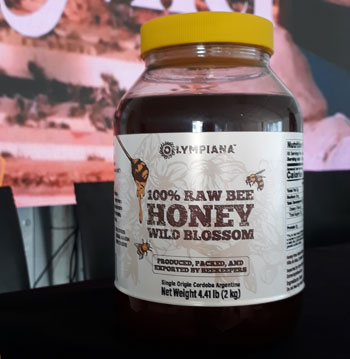HONEY FROM NATIVE FOREST
EXPORT OF MISTOL HONEY FOR A GOURMET DISTRIBUTOR
July 5th, 2024
 Versión en Castellano
Versión en Castellano (Espacio Apícola - July 5, 2024) The Beekeeping and Agricultural Cooperative of Villa de Soto, in western Córdoba (Argentina), completed its first export of bottled honey to the United States. In front of Villa de Soto city extends the "Traslasierra" Valley, the last refuge of the Native Forest conserved in Córdoba Province that extends in an arc, located mainly to the west of the "Sierras Grandes" (great hills), which begins to the south on the border with San Luis province and lies in the north towards meeting the "Ansenuza" Sea, a high salinity lagoon, the largest salt lake in South America, which is located in the northeast of Córdoba province, Argentina.
(Espacio Apícola - July 5, 2024) The Beekeeping and Agricultural Cooperative of Villa de Soto, in western Córdoba (Argentina), completed its first export of bottled honey to the United States. In front of Villa de Soto city extends the "Traslasierra" Valley, the last refuge of the Native Forest conserved in Córdoba Province that extends in an arc, located mainly to the west of the "Sierras Grandes" (great hills), which begins to the south on the border with San Luis province and lies in the north towards meeting the "Ansenuza" Sea, a high salinity lagoon, the largest salt lake in South America, which is located in the northeast of Córdoba province, Argentina.This Native Forest composed of the characteristic vegetation of the Western "Chaco" region has several honey sources. Among them, the different species of Prosopis stand out, popularly known as carob trees ("algarrobos" are the same genus than "mesquite"), provide abundant nectar with which honey bees make white honey at the beginning of spring and another amber-colored honey that comes from "mistol" in the middle of the spring season, already with higher temperatures. The "jarilla", the "atamisqui", the "piquillín" are other of the characteristic blooms of the region.
Mistol honey is very dense and viscous, with an intense aroma and flavor, ideal for a harmonious pairing with different cheeses, from the creamiest and freshest to the hardest, since its sweetness does not cloy or cover up the freshness of some of them or the flavors of the other cheeses that it can accompany. The initial presentation, in a first shipment of just over 20,000 kg of predominantly mistol honey, was made in PET flasks from Starplastic S.A., also a Cordoban company, with 2kg capacity, since its importer is a distributor of gourmet products for hotels, restaurants or even food industries. Without a doubt, an excellent tasting opportunity to awaken the interest of demanding palates eager of pleasant and novel flavors. Commercially, this honey remains liquid and it is recommended to be stored in a cool, dry place and isolated from sunlight due to its foaming tendency in the presence of high temperatures.
It should be added that this typical blossom specie of the warm, if not torrid climates, dryland forest, mistol, was renamed in academic circles in 2016 as Sarcomphalus mistol, however its basonym Ziziphus mistol (Griseb, 1874), takes us back to landscapes of the highly prized and emblematic Ziziphus spina-christi of Middle East and South Asia, with taxonomic characteristics very similar to it, to the "jujube" and the other Ramaceae of this genus.
Without a doubt, the Bringas brothers and the entire board of directors of the cooperative had a lot to celebrate at the recent "ExpoMiel" that they organized at "Posta San Roque", in Villa de Soto downtown. We hope that this will be a great and successful beginning for the beekeepers of this cooperative, for the importing company and particularly for this mistol honey, until now discriminated in the markets with low prices only because its color, to reach the podium of the most desired honeys in the world.
Information generated by "Espacio Apícola" the Argentine Beekeepers' Magazine apicultura.com.ar

